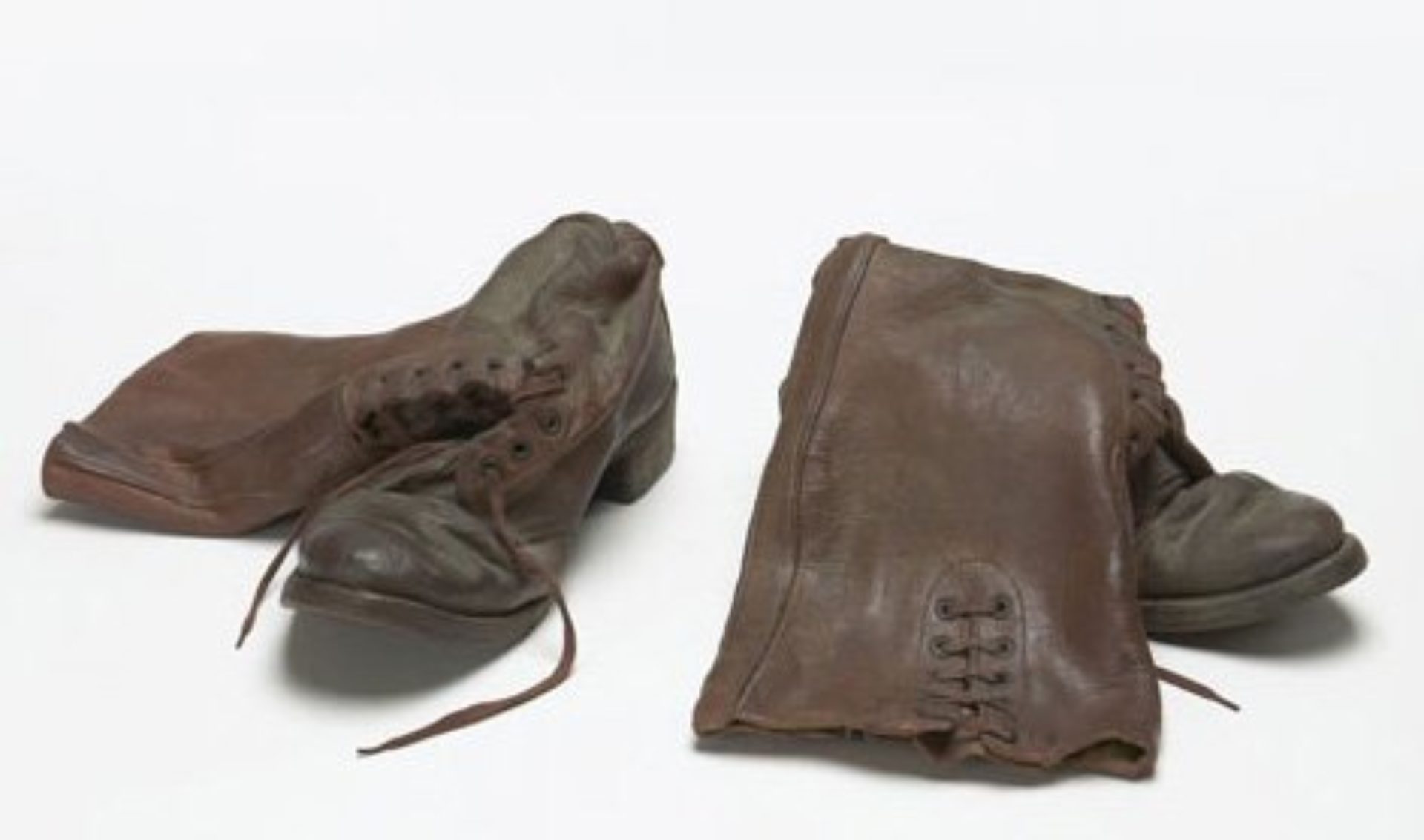
Marilyn Levine, John's Mountie Boots, 1973, ceramic and mixed media. MacKenzie Art Gallery, University of Regina collection.
About the Artwork
John’s Mountie Boots are reproductions of boots that John Nugent, a local Saskatchewan artist and colleague, had worn. Levine used clay to reproduce the shoes so realistically that it was difficult to see the difference between the clay boots and the originals. Writer Myrna Oliver quotes reviewer Leah Ollman as writing, “Marilyn Levine is one of those artist/tricksters whose illusionistic technique is so refined that her work blurs the boundaries between real and represented.” (Oliver, 2005)
On Levine’s reasons and justification for making these hyper–realistic sculptures writer Roberta Smith comments, “When a friend brought her his beat-up work shoes, she began to see old leather objects as metaphors for the passage of time and the scars of life. She developed a meticulous trompe l’oeil style, capturing in fired clay and glaze the forms, surfaces and creases of much-used luggage, gloves, handbags, a golf bag, a knapsack and even leather jackets hanging from coat hooks.” (Smith, 2005)
In an article in Ceramics Today, Levine’s process and practice is further revealed, “Levine uses a stoneware body to which she adds 1 1/5 – 2% chopped nylon fiber, a process she developed in 1969. She builds the pieces much like you would build a real suitcase, bag, or whatever. However, clay being much heavier than leather, or canvas, needs to be supported with an interior armature, in anything larger than a small handbag. Levine’s gets her surface colors from colored engobes she rolls onto the slab prior to the basic construction.” (Ceramics Today, undated)
During her career, Levine further explored the idea of trompe l’oeil and continued to make many leather-like objects from clay. Some works were so popular they would sell and resell at higher and higher prices several times during an opening gallery reception. She was an amazing technician and understood the science behind the making and decorating of clay.
About the Artist
Marilyn Levine was born in Medicine Hat, Alberta in 1935 and grew up in Calgary, Alberta. She received a Bachelor and a Master of Science with a major in chemistry, at the University of Alberta in Edmonton in 1957 and 1959 respectively. Levine became interested in ceramics while working in a Regina, Saskatchewan studio in the 60s. Levine was part of a group of Saskatchewan artists including Joe Fafard, Victor Cicansky, David Thauberger and Jerry Didur who used clay as a sculptural medium. She, like her many contemporaries, earned many awards and commissions over the years of her art practice, and in 1998 Levine had a retrospective exhibition at the MacKenzie Art Gallery.
Levine applied her knowledge of chemistry to her art practice and produced a variety of highly realistic surfaces and forms. In 1969 she moved to Berkeley, California and received a Master of Arts degree in 1970 and a Master of Fine Arts degree in 1971 while studying at the University of California. Levine taught art at the University of Regina in Saskatchewan, the University of Utah, in Salt Lake City, and at the University of California, in Berkeley. After moving to Berkeley in the 70s, Levine lived the rest of her life in California where she passed away in 2005.
Things to Think About
- Some people would question whether Levine’s sculptures are “real art” because they are just ordinary objects reproduced realistically. The Object as the Subject was the title of one show where Levine exhibited her work. Discuss these concepts about real art versus object as subject.
- Time is often a subject addressed by artists. How does Levine suggest time in John’s Mountie Boots?
- Have you ever met someone that you associate with a certain object or symbol? How did they get this trait/symbol, and does it fully represent that person?
Post your artwork online using the hashtag #studiosundaysyqr!
Studio Activity

“This paintbrush and paint bottle represents all of the things my grandma paints on wood.” - Emma

“This horse represents my Nana because she loves riding horses with me." - Cate
CREATE YOUR OWN PAINTING
Levine created a ceramic piece that was a representation of her colleagues’ boots. Using either air-dry clay or a pottery app, create an artwork that is a positive representation of someone you know.
What you Need:
- Paper
- Pencil
- Air-dry clay or smart phone apps: Pottery.ly 3D (Apple), Pottery Master (Google Play)
What you Do:
- Choose a person you know to create a ceramic piece about.
- Create a list about that person that has positive traits, likes, hobbies, etc.
- Use either air-dry clay or apps such as Pottery.ly 3D (Apple App Store) or Pottery Master (Google Play Store) to create a ceramic artwork using the positive traits, likes and hobbies of the person you chose.

